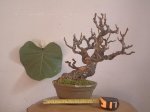SU2
Omono
I'm still very confused on this topic, all of my trees are collected and I'd originally thought I had to do this 'ideally' in spring, but that with stuff like bougies/crapes I could do it much later (and that panned-out)
I thought fall was a no-no for collecting, but was told by someone I highly respect in this area (who lives in my region) that this is actually a good time for Oaks, as, after the rainy season, they've got the densest root-ball under their trunk that they'll have all year; when it gets drier, it relies more upon extended roots. This seems to have worked (I collected an oak ~2wks ago and it's looking good still, it was trunk-chopped maybe 3mo ago so had re-grown a few ~5' branches), so now I'm wondering- is it over for the season or are there others I should consider? I can't do more oaks as I didn't prepare anymore (ie I'd have to do their trunk-chop and collection at same time, doubt they'd survive that..), but would love to get a couple more specimen if at all possible!!
Thanks
I thought fall was a no-no for collecting, but was told by someone I highly respect in this area (who lives in my region) that this is actually a good time for Oaks, as, after the rainy season, they've got the densest root-ball under their trunk that they'll have all year; when it gets drier, it relies more upon extended roots. This seems to have worked (I collected an oak ~2wks ago and it's looking good still, it was trunk-chopped maybe 3mo ago so had re-grown a few ~5' branches), so now I'm wondering- is it over for the season or are there others I should consider? I can't do more oaks as I didn't prepare anymore (ie I'd have to do their trunk-chop and collection at same time, doubt they'd survive that..), but would love to get a couple more specimen if at all possible!!
Thanks

